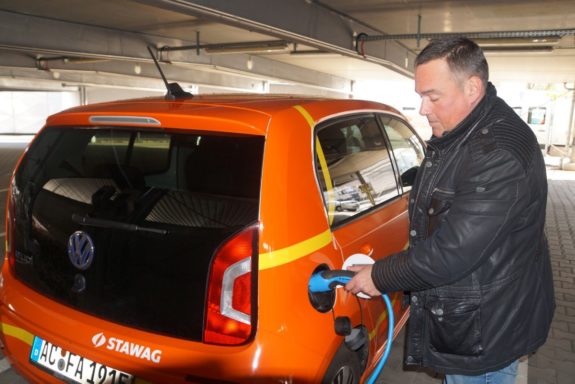Is e-mobility viable? You bet! Georg Radermacher is on the road every day for the STAWAG, and is totally impressed with his electric service vehicle.
Start of shift for Georg Radermacher. He turns the ignition key of his service vehicle, the lights go on in the cockpit, and the sound of a radio announcer’s voice comes softly from the speakers. And that’s all! There’s no engine sound as the orange VW ‘Up’ rolls out of the STAWAG depot and into the city traffic.
If you want to know what else is different when you’re driving a car with an electric motor – just ask Georg: he should know. For more than five years now, he’s been exclusively driving the e-vehicles of the company fleet. And he wouldn’t want to go back to any other kind of propulsion. “Driving is totally stress-free. The electric motor develops plenty of power even at low revs, so it accelerates faster than most combustion engines. The turning circle is nice and small, which makes manoeuvring very comfortable. All in all, this means a definite plus in terms of driving pleasure in the city.”
Quiet speedster
The traffic lights at the Bahnhofsplatz are red and crowds of pedestrians are crossing the street in front of us on their way into town. “Just watch their faces,” says Georg, grinning – and he’s right! Although they’re in a hurry, many people cast a curious glance at the quiet speedster standing at the lights: something exotic…
We swiftly overtake an ADAC service vehicle. The “yellow angel” from the automobile club is obviously looking for the young lady standing next to her car over there in front of the garage, waving at him. “Roadside assistance,” says Georg, commenting on the scene. “I’ve never needed any with electric cars. They are extremely reliable.” He tells me how, in the early days, a false assessment of the battery capacity was about the only thing that would occasionally lead to a work journey being unintentionally interrupted. But the current ‘e-Up’ model has a range of 130 kilometres. That’s enough for a STAWAG service employee to run all his routine errands, for example reading meters for electricity, gas, water and heating, for two whole days, and still have something left “in the tank”.
Georg has just parked his ‘Up’ at Aachen’s historic Market Place to pay a visit to a customer, and a group of Dutch tourists have already gathered around the vehicle. They want to know what it’s like to drive. And how far you can get on a fully charged battery. And whether the electricity used to charge the battery comes from regenerative sources. “I get asked questions like this almost every day,” says Georg. “Even children notice immediately that there’s something different about this vehicle. Often, the parents will kneel next to the car and explain to their kids that it’s powered by electricity. And why that’s a good thing.”
Fill her up, please!
At the Theaterplatz there’s a STAWAG fast-charging station. Georg wants to show how easy it is to charge the battery – but before he can glide the Smart into the parking bay, we have to wait for two pedestrians who are having a little chat there to clear the space for us. “That also happens a lot.” Georg says. “The car moves silently and sometimes it’s as if people were deaf.” He gets out and speaks to the two women. They turn in surprise and just say, “Oh!” And then they add that it would be nice if all cars were that quiet.
The working day is over. Georg parks the ‘Up’ on the roofed parking level at the STAWAG depot. He plugs the fast-charge cable into the socket on the rear right of the car. This will fill the 70 HP battery for the next day with energy for the motor – and for the air con, the heating, the power steering and the heated side mirrors.
Same routine tomorrow? More or less, says Georg. And the same amount of fun. “I always have plenty of that when I’m on the road with the speedster.” But for now, he’s off home. “For me, a relaxing evening is spent in the kitchen. I cook a tasty evening meal for my folks, and the job is off my mind for a while.”




